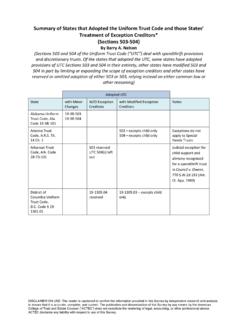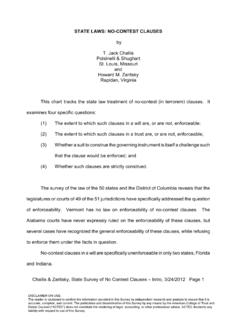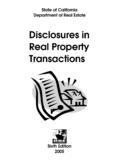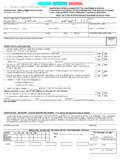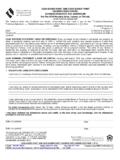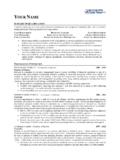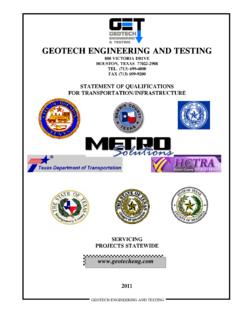Transcription of THE RULE AGAINST PERPETUITIES: A SURVEY OF …
1 THE RULE AGAINST perpetuities : A SURVEY OF STATE (AND ) LAWAt common law, the rule AGAINST perpetuities provided that:No [nonvested property] interest is good unless it must vest, if at all, not laterthan 21 years after some life in being at the creation of the , The Rule AGAINST perpetuities 201 (4th ed. 1942). Under the common law rule, theinterest was invalid unless it was certain on the date the interest was created that it wouldvest within 21 years after the death of the last designated life in being at that time (the common law period ). The common law rule ignored any events that occurred after theinterest was created, and focused only on what was certain to occur or not to occur whenthe interest was common law rule remains intact in only three states , however Alabama, NewYork, and Texas.
2 Three more states Iowa, Mississippi and Oklahoma have thecommon law rule, with the wait-and-see modification that determines whether an interestwas valid based on whether it actually vested within the common law period, rather thanwhether it had to do so in all beginning of the movement away from the common law rule began in 1979,when the Restatement (Second) of Property suggested that this approach wasunreasonable, because it ignored events that, in some cases, had already occurred beforethe court or the parties had to determine the validity of the interests created. RestatementThe Rule AGAINST perpetuities , 50-State SURVEY , Page 1 DISCLAIMER ON USE: The reader is cautioned to confirm the information provided in this SURVEY by independent research and analysis to ensure that it is accurate, complete, and current.
3 The publication and dissemination of this SURVEY by any means by the American College of Trust and Estate Counsel ( ACTEC ) does not constitute the rendering of legal, accounting, or other professional advice. ACTEC disclaims any liability with respect to use of this SURVEY .(Second) of Property (Donative Transfers) (1979). The Restatement recommendeda wait-and-see most significant change in the state laws on the rule AGAINST perpetuities derivefrom the 1986 enactment by the Uniform Law Commissioners of the Uniform Statutory RuleAgainst perpetuities ( USRAP ). See Waggoner, The Uniform Statutory Rule AgainstPerpetuities, 21 Real Prop., Prob., & Tr. J. 569 (1986). The USRAP both adopted a wait-and-see approach to the rule AGAINST perpetuities , and added an alternate 90-year period(measured from the creation of the interest or power) for the rule, allowed the use of cypres to fix RAP violations, as well as making several other less major changes to thecommon law USRAP (either alone or as part of the Uniform Probate Code)
4 Has been2adopted in twenty-five states and the District of Columbia (Arizona, Arkansas, California,Colorado, Connecticut, District of Columbia, Florida, Georgia, Hawaii, Indiana, Kansas,Massachusetts, Michigan, Minnesota, Montana, Nebraska, Nevada, New Mexico, NorthCarolina, North Dakota, Oregon, South Carolina, Tennessee, Utah, Virginia, and WestVirginia). Several of these states , however, have made substantial modifications or addedmajor most substantive rules adopted by the USRAP are in the first five sections. USRAP 1(a) codifies the validating side of the common-law rule, but rejects the invaliding This approach appears to have been first adopted by statute in Pennsylvania in 1947. 120 Pa. Stat.
5 6104(b). See Leach, perpetuities Legislation, Hail Pennsylvania , 108 Rev. 1124 (1960). In 1990 the Uniform Probate Code made the Uniform Statutory Rule an official part of the2 Uniform Probate Code as Part 9 of Article II. See UPC 2-901 to Rule AGAINST perpetuities , 50-State SURVEY , Page 2 DISCLAIMER ON USE: The reader is cautioned to confirm the information provided in this SURVEY by independent research and analysis to ensure that it is accurate, complete, and current. The publication and dissemination of this SURVEY by any means by the American College of Trust and Estate Counsel ( ACTEC ) does not constitute the rendering of legal, accounting, or other professional advice. ACTEC disclaims any liability with respect to use of this The USRAP states that a nonvested property interest that is valid under the common-law rule is valid under the USRAP.
6 The USRAP adopts a wait-and-see approach for theinvalidating side of the rule, by providing that an interest that is not certain to vest with theperiod of the common law rule is still valid if it actually vests within 90-years following thedate it is created. USRAP 1(b) and 1(c) adopt a similar rule for powers of appointment. USRAP 1(b) states that a presently-exercisable general power of appointment is always vested, butunder the USRAP, a general power that is not presently exercisable because it is subjectto a condition precedent, is valid if either the condition precedent is certain to be satisfiedor to become impossible to satisfy within the common law period, or if the conditionprecedent is actually satisfied or actually becomes impossible to satisfy within 90 yearsafter its creation.
7 USRAP 1(c) states that a nongeneral power of appointment or generaltestamentary power of appointment is valid under the USRAP if, when it is created, it iscertain to be irrevocably exercised or otherwise to terminate during the common law period,or if it is actually irrevocably exercised or actually otherwise terminates within 90 years afterits 1(d) provides that, for purposes of measuring the common law period ofthe rule, the chance that a child will be born to an individual after the individual s death 1990, the USRAP was modified to add USRAP 1(e), which is designed to avoidunintended adverse results that could arise from a savings clause that states that themaximum time of vesting or termination of any interest or trust occur no later than 21 yearsafter the death of the survivor of specified lives in being at the creation of the trust, or ifThe Rule AGAINST perpetuities , 50-State SURVEY , Page 3 DISCLAIMER ON USE: The reader is cautioned to confirm the information provided in this SURVEY by independent research and analysis to ensure that it is accurate, complete, and current.
8 The publication and dissemination of this SURVEY by any means by the American College of Trust and Estate Counsel ( ACTEC ) does not constitute the rendering of legal, accounting, or other professional advice. ACTEC disclaims any liability with respect to use of this , 90 years after the creation of the trust. Such a provision could create a problem ifused in a trust whose terms otherwise violated the common-law rule. If the savings clauseactually sets the duration of the trust, it could actually create a perpetuities violation. Section 1(e) thus provides that language in a governing instrument that seeks to disallowthe vesting or termination of any interest or trust until or beyond the later of the expirationof the common law period or a period that exceeds or might exceed the common lawperiod, is inoperative to the extent it produces a period of time that exceeds 21 years afterthe death of the survivor of the specified lives.
9 USRAP 2 defines the time when, for purposes of the USRAP, when a nonvestedproperty interest or a power of appointment is created. Section 2(a) states that generalproperty law determines when a nonvested property interest or power of appointment iscreated, except as otherwise provided in Section 5 of the 2(b) adopts the general common law rule that, if a person who alone canexercise a power created by a governing instrument to become the unqualified beneficialowner of a nonvested property interest (or a property interest subject to a power ofappointment described in USRAP 1(b) (a general power subject to a condition precedent)or 1(c) (a testamentary general or special lifetime power)), the nonvested property interestor power of appointment is deemed to be created when the power to become theunqualified beneficial owner terminates.
10 This section includes alternate language statingthat, for purposes of the USRAP, a joint power with respect to community property or tomarital property under the Uniform Marital Property Act held by a married couple is treatedas a power exercisable by one person Rule AGAINST perpetuities , 50-State SURVEY , Page 4 DISCLAIMER ON USE: The reader is cautioned to confirm the information provided in this SURVEY by independent research and analysis to ensure that it is accurate, complete, and current. The publication and dissemination of this SURVEY by any means by the American College of Trust and Estate Counsel ( ACTEC ) does not constitute the rendering of legal, accounting, or other professional advice. ACTEC disclaims any liability with respect to use of this 2(c) provides that nonvested property interests and powers of appointmentarising out of transfers to a previously funded trust or other existing property arrangementare deemed to be created when the nonvested property interest or power of appointmentarising out of the original contribution was created.
